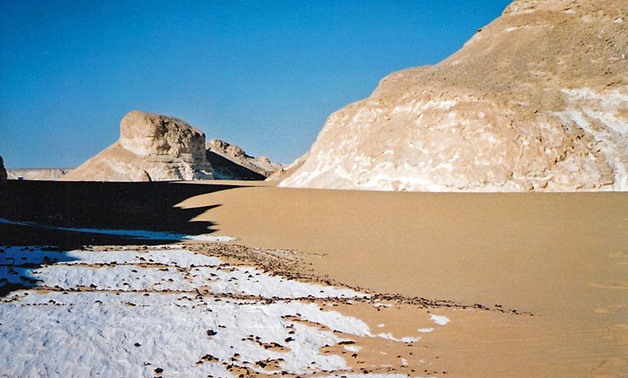
White Desert, Western Egypt – wikimedia commons/neiljs
CAIRO – 6 January 2018: Egypt’s Western Desert has it all; breathtaking landscapes, fossilized creatures, beautiful oases, towering mountains, pre-historic caves, ancient Egyptian temples, hot and cold springs and rich, vibrant cultures.
The desert covers an area of 262,800 square miles (680,650 square kilometers), about two-thirds of the land area of Egypt; it lies west of the Nile, extending up to the Libyan border, and borders with Sudan to the south.
When I visited the Sinai Desert in Eastern Egypt last year, I began to understand why people are so mesmerized by this place. I could not take my eyes off of the mountains; their towering presence was warm and comforting. My thoughts rested on the vast expanse of sand around me, only moving with the breeze. I had fallen in love with the Sinai Desert.
However, after two days of camping under the starlight, my tour guide informed me that the real deserts lie in the west.
The magic of the Western Desert
The western desert is believed to possess a spiritual energy, from which mystics have drawn upon in their search for enlightenment. Moreover, Siwa's salt lakes are known for having natural medicinal properties, they contain an unusually high salt concentration, which Bedouin people have used to nurse their wounds over the centuries.
The desert oases
In the Western Desert you can find the oases of Bahariya, Farafra, Dakhla, Kharga, and the famous Siwa.
These four Oases form a cluster, known as the “Oasis Circle”, encloses most of the attractions the desert has to offer. For instance, both the White Desert and al-Ababa valley are a part of al-Farafra Oasis.
Al-Ababa valley is one of the most eye-catchy places in Farafra. Its sculpture-like rock formations were formed by erosion over the past million years. Due to its geological structure the area has over 100 natural springs, most of which are used for irrigation and land cultivation but some (because of their warm temperature and slight sulfur percentage) have become idyllic spots for swimming and relaxation.
As for the White Desert (al-Sahara al-Beida), it is known as one of the most beautiful natural reserves in Egypt, where one can find rare sculptures, plants, animals, caves, ancient tombs and houses dating back to the Roman era. Most of the sculptures in the White Desert are made of soft lime stone.
The spectacular Black Desert (al-Sahara al-Suda) is located near the Bahariya Oasis. It was announced officially by the Egyptian authorities as a natural reserve in 2010. It is considered as one of the most desirable destinations for desert-camping adventurers.
Most of the land in the black desert is covered with dolerite, basalt and quartz stones; these stones give it its namesake color.
The highest mountain in the Black Desert is called the British mountain (Jabal al-Englizi). When the British came to Egypt, they used this mountain for monitoring the surrounding desert as it was the highest point in the region.
As for Siwa, it has its own reputation as destination for healing and relaxing. Many places can be visited within the Siwa Oases, including the mountain camp hot spring, Ghaliet Ecolodge pool, Fatnas Island, Bir Wahed hot spring and the Temple of Amun.
The Great Sand Sea
The Great Sand Sea is located in the area between Siwa Oases and Gilf Kebir. It is a continuous mass of sand dunes which sit atop layers of limestone and a large amount of the groundwater. It extends for about 650 kilometers vertically and 300 kilometers from east to west, and covers about 10 percent of the total area of western desert. Despite the water underneath, there is not a single surface level water source for 150 square miles, which is extreme even for the Sahara
At the southern end of the sand sea lies the silica glass field which is home to amazing yellow-green glass pebbles and is the only instance of this natural phenomenon ever found. The glass, smoothed by time, is theorized to have been formed by a meteor crashing in the desert and causing the sand to fuse due to the intense heat.
Gilf Kebir
Gilf Kibir is a huge plateau in the southwest corner of Egypt bordering with Libya and Sudan. In recent years it has become famous as a tourist site. The area is rich with vast sand valleys, sand dunes, and caves that date back to prehistoric eras.
The rocks and geological formations in the Gilf Kibir National Park are concrete evidence of an ancient history that dates back to hundreds of millions of years ago. Researchers believe that this area demonstrates the ecological history, not only of the region, but of the whole planet itself.

Comments
Leave a Comment